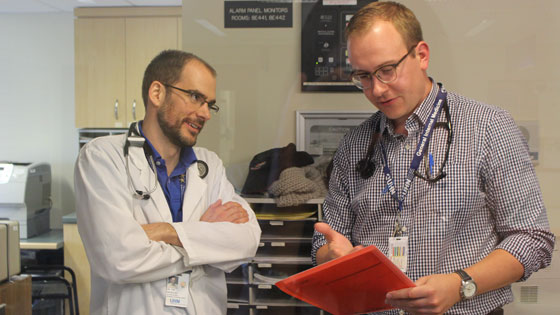
Dr. Tom MacMillan (L) and GIM resident Dr. Kevin Venus go over patient referrals before starting their day in the GIM clinics. TWH GIM has restructured its outpatient care to ensure patients receive the care they need without being admitted to the hospital (Photo: UHN)
A patient with diabetes arrives at the Toronto Western Hospital (TWH) Emergency Department feeling unwell. Something is wrong with their blood sugar levels and kidney function.
After being assessed by Emergency staff, the patient is stable and can probably go home safely after being given some medication, but will need a follow-up appointment with a specialist within the next few days – something that the Emergency Department isn't equipped to arrange.
As a precaution, the patient gets admitted to hospital and referred to the General Internal Medicine (GIM) unit. On the one hand, this is a guaranteed way to ensure the patient will see a specialist, but on the other the patient ends up staying overnight at the hospital.
It's an inefficient way of getting patients to the specialist they need.
That's why the TWH GIM team has reimagined how they deliver care – setting up new clinics and reorganizing current ones to fit patient needs, keeping patients out of the hospital and, for those who do need to be admitted, getting them discharged sooner.
"Over 90 per cent of patients who come to the Emergency Department and are referred to GIM get admitted, and we were also aware of a high number of patients being admitted for only 24 hours," says Dr. Tom MacMillan, Staff Physician, GIM.
"Taken together this indicated to us that our team needed to come up with a better system to assess and follow up with these patients as well as keep them out of the hospital."
After a department retreat to discuss how to better deliver care, the GIM department launched the TWH Rapid Referral GIM Clinic earlier this month.
Patients with an acute internal medicine issue who arrive at the TWH Emergency Department or the hospital's Family Health Team and don't need to be admitted are now referred to the clinic.

GIM physician Dr. David Frost co-led the reorganization of the departments' outpatient clinics (Photo: David Frost)
"It's a much better system because the patient not only avoids being admitted but also leaves the hospital with a follow-up appointment date and time," says Dr. David Frost, Staff Physician, GIM who co-led the reorganization. "Patients are happy to go home when they know there is a plan for their care and this also takes some pressure off the Emergency Department."
In its first week of operation, the clinic diverted six patients from hospital admission.
The referral approach is being applied to all of GIM's outpatient clinics. It's also resulted in the restructuring of staff and resident rotations to provide a new model of ambulatory care for the specialty.
In the past, patients referred to GIM were followed by one physician regardless of whether they had transitioned from inpatient to outpatient. This system made it challenging for physicians to manage their workload.
With the new set-up, one GIM physician and resident attend to the outpatient clinics, held five days a week for an entire month, and organized around patient need: Rapid-referral, Rapid-referral Follow-up, Hypertension, Post-discharge and a general GIM outpatient clinic.
The rest of the year, the GIM physician can devote to research and working on the inpatient units.
In addition to the new rapid referral clinic, GIM also introduced a Post-discharge clinic for inpatients who are well enough to be discharged, but still need follow up care.
Instead of being kept in the hospital a few extra days so that staff can "keep an eye on them," they are assessed by the inpatient team and referred to the clinic – reducing the overall length of stay in hospital for the patient and decreasing the chance they will be readmitted.
Only a few weeks in, the change has so far been a great experience for the GIM department.
"We are seeing the patients in the clinics that they were designed to see," says Dr. MacMillan. "This new system is proving to be a safe and timely way for us to treat our patients without admitting them to the hospital."
